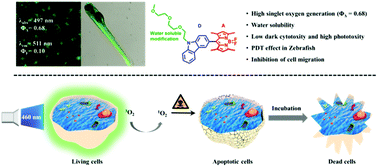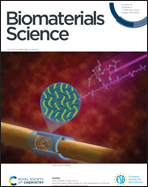A water soluble carbazolyl-BODIPY photosensitizer with an orthogonal D–A structure for photodynamic therapy in living cells and zebrafish†
Abstract
A novel photosensitizer carbazolyl-BODIPY (Cz-BODIPY) with an orthogonal donor–acceptor structure was developed for photodynamic therapy (PDT). The photosensitizer Cz-BODIPY showed strong singlet oxygen sensitizing capability (ΦΔ = 0.68 in MeOH), excellent water solubility in dilute solution, and high photostability. The photosensitizer Cz-BODIPY exhibited negligible dark cytotoxicity and high phototoxicity (IC50 0.45 μM). Cz-BODIPY could induce cell apoptosis upon light illumination. Three cell states including living cells, apoptotic cells, and dead cells in the PDT process of Cz-BODIPY were determined via the Hoechst 33342/PI dual staining assays. The ROS (reactive oxygen species) generation in living cells during the PDT process of Cz-BODIPY was captured by the ROS detector, dihydroethidium (DHE). The photosensitizer Cz-BODIPY could be assimilated by zebrafish to generate ROS and diminish the integrity of zebrafish tissue upon light illumination. Tumor cell growth could be inhibited by Cz-BODIPY upon light illumination. The photosensitizer Cz-BODIPY displayed potential in real PDT application.

- This article is part of the themed collection: Biomaterials Science Most Popular 2020


 Please wait while we load your content...
Please wait while we load your content...